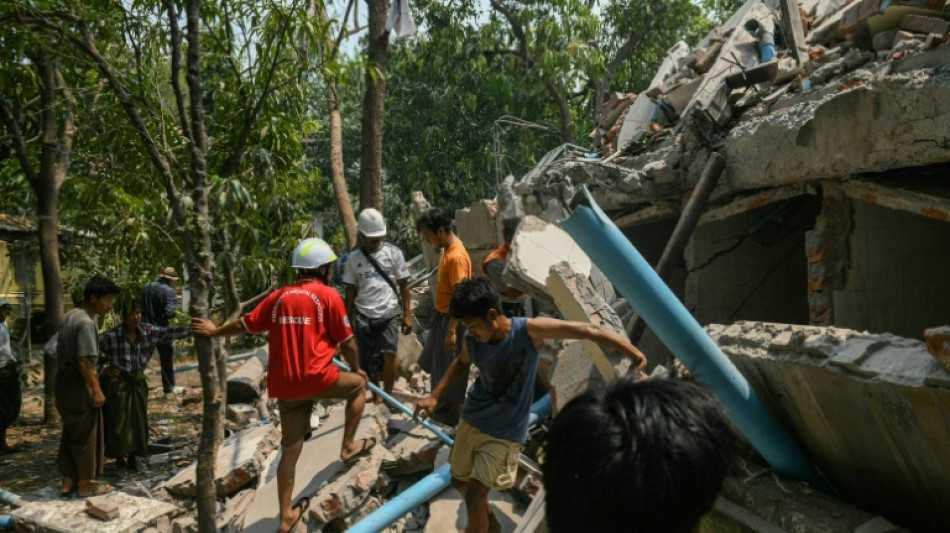
-
 Zuckerberg denies Meta bought rivals to conquer them
Zuckerberg denies Meta bought rivals to conquer them
-
Starc stars as Delhi beat Rajasthan in Super Over

-
 Weinstein asks to sleep in hospital, citing prison 'mistreatment'
Weinstein asks to sleep in hospital, citing prison 'mistreatment'
-
Amorim asks McIlroy to bring Masters magic to Man Utd

-
 Ruud keeps Barcelona Open defence on course
Ruud keeps Barcelona Open defence on course
-
Trump tariffs could put US Fed in a bind, Powell warns

-
 CONCACAF chief rejects 64-team World Cup plan for 2030
CONCACAF chief rejects 64-team World Cup plan for 2030
-
Putin praises Musk, compares him to Soviet space hero

-
 Son to miss Spurs' Europa League trip to Frankfurt
Son to miss Spurs' Europa League trip to Frankfurt
-
US senator in El Salvador seeking release of wrongly deported migrant

-
 Trump tariffs could put the US Fed in a bind, Powell warns
Trump tariffs could put the US Fed in a bind, Powell warns
-
US judge says 'probable cause' to hold Trump admin in contempt

-
 India opposition slams graft charges against Gandhis
India opposition slams graft charges against Gandhis
-
Nate Bargatze to host Emmys: organizers

-
 US Fed Chair warns of 'tension' between employment, inflation goals
US Fed Chair warns of 'tension' between employment, inflation goals
-
Trump touts trade talks, China calls out tariff 'blackmail'

-
 US judge says 'probable cause' to hold govt in contempt over deportations
US judge says 'probable cause' to hold govt in contempt over deportations
-
US eliminates unit countering foreign disinformation

-
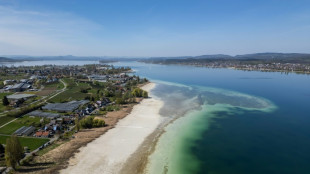 Germany sees 'worrying' record dry spell in early 2025
Germany sees 'worrying' record dry spell in early 2025
-
Israel says 30 percent of Gaza turned into buffer zone

-
 TikTok tests letting users add informative 'Footnotes'
TikTok tests letting users add informative 'Footnotes'
-
Global uncertainty will 'certainly' hit growth: World Bank president

-
 EU lists seven 'safe' countries of origin, tightening asylum rules
EU lists seven 'safe' countries of origin, tightening asylum rules
-
Chelsea fans must 'trust' the process despite blip, says Maresca

-
 Rebel rival government in Sudan 'not the answer': UK
Rebel rival government in Sudan 'not the answer': UK
-
Prague zoo breeds near-extinct Brazilian mergansers

-
 Macron to meet Rubio, Witkoff amid transatlantic tensions
Macron to meet Rubio, Witkoff amid transatlantic tensions
-
WTO chief says 'very concerned' as tariffs cut into global trade
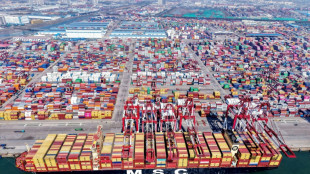
-
 Sports bodies have 'no excuses' on trans rules after court ruling: campaigners
Sports bodies have 'no excuses' on trans rules after court ruling: campaigners
-
Zverev joins Shelton in Munich ATP quarters

-
 The Trump adviser who wants to rewrite the global financial system
The Trump adviser who wants to rewrite the global financial system
-
US senator travels to El Salvador over wrongly deported migrant

-
 UN watchdog chief says Iran 'not far' from nuclear bomb
UN watchdog chief says Iran 'not far' from nuclear bomb
-
Trump says 'joke' Harvard should be stripped of funds

-
 Macron vows punishment for French prison attackers
Macron vows punishment for French prison attackers
-
Canada central bank holds interest rate steady amid tariffs chaos
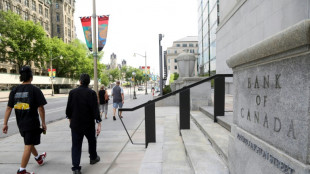
-
 Rubio headed to Paris for Ukraine war talks
Rubio headed to Paris for Ukraine war talks
-
Australian PM vows not to bow to Trump on national interest

-
 New attacks target France prison guard cars, home
New attacks target France prison guard cars, home
-
Global trade uncertainty could have 'severe negative consequences': WTO chief
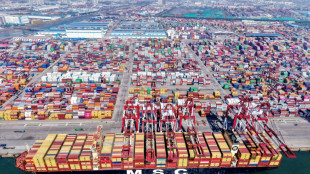
-
 Google facing £5 bn UK lawsuit over ad searches: firms
Google facing £5 bn UK lawsuit over ad searches: firms
-
Onana to return in goal for Man Utd against Lyon: Amorim

-
 Tiktok bans user behind Gisele Pelicot 'starter kit' meme
Tiktok bans user behind Gisele Pelicot 'starter kit' meme
-
'Put it on': Dutch drive for bike helmets

-
 China's Xi meets Malaysian leaders, vows to 'safeguard' Asia allies
China's Xi meets Malaysian leaders, vows to 'safeguard' Asia allies
-
France urges release of jailed Russian journalists who covered Navalny

-
 Gabon striker Boupendza dies after 11th floor fall
Gabon striker Boupendza dies after 11th floor fall
-
UK top court rules definition of 'woman' based on sex at birth

-
 PSG keep Champions League bid alive, despite old ghosts reappearing
PSG keep Champions League bid alive, despite old ghosts reappearing
-
Stocks retreat as US hits Nvidia chip export to China
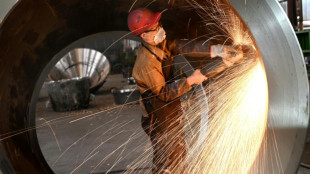

Scientists explain why Myanmar quake was so deadly
Experts say that the devastating earthquake in Myanmar on Friday was likely the strongest to hit the country in decades, with disaster modelling suggesting thousands could be dead.
Automatic assessments from the United States Geological Survey (USGS) said the shallow 7.7-magnitude quake northwest of the central Myanmar city of Sagaing triggered a red alert for shaking-related fatalities and economic losses.
"High casualties and extensive damage are probable and the disaster is likely widespread," it said, locating the epicentre near the central Myanmar city of Mandalay, home to more than a million people.
Myanmar's ruling junta said on Saturday morning that the number killed had passed 1,000, with more than 2,000 injured.
However, the USGS analysis said there was a 35 percent chance that possible fatalities could be in the range of 10,000-100,000 people.
The USGS offered a similar likelihood that the financial damage could total tens of thousands of millions of dollars, warning that it might exceed the GDP of Myanmar.
Weak infrastructure will complicate relief efforts in the isolated, military-ruled state, where rescue services and the healthcare system have already been ravaged by four years of civil war sparked by a military coup in 2021.
- Dangerous fault -
Bill McGuire, emeritus professor of geophysical and climate hazards at University College London (UCL), said it was "probably the biggest earthquake on the Myanmar mainland in three-quarters of a century".
A 6.7-magnitude aftershock struck minutes after the first and McGuire warned that "more can be expected".
Rebecca Bell, a tectonics expert at Imperial College London (ICL), suggested it was a side-to-side "strike-slip" of the Sagaing Fault.
This is where the Indian tectonic plate, to the west, meets the Sunda plate that forms much of Southeast Asia -- a fault similar in scale and movement to the San Andreas Fault in California.
"The Sagaing fault is very long, 1,200 kilometres (745 miles), and very straight," Bell said. "The straight nature means earthquakes can rupture over large areas -- and the larger the area of the fault that slips, the larger the earthquake."
Earthquakes in such cases can be "particularly destructive", Bell added, explaining that since the quake takes place at a shallow depth, its seismic energy has dissipated little by the time it reaches populated areas above.
That causes "a lot of shaking at the surface", Bell said.
- Building boom -
Myanmar has been hit by powerful quakes in the past.
There have been more than 14 earthquakes with a magnitude of 6 or above in the past century, including a magnitude 6.8 earthquake near Mandalay in 1956, said Brian Baptie, a seismologist with the British Geological Survey.
Ian Watkinson, from the department of earth sciences at Royal Holloway University of London, said what had changed in recent decades was the "boom in high-rise buildings constructed from reinforced concrete".
Myanmar has been riven by years of conflict and there is a low level of building design enforcement.
"Critically, during all previous magnitude 7 or larger earthquakes along the Sagaing Fault, Myanmar was relatively undeveloped, with mostly low-rise timber-framed buildings and brick-built religious monuments," Watkinson said.
"Today's earthquake is the first test of modern Myanmar's infrastructure against a large, shallow-focus earthquake close to its major cities."
Baptie said that at least 2.8 million people in Myanmar were in hard-hit areas where most lived in buildings "constructed from timber and unreinforced brick masonry" that are vulnerable to earthquake shaking.
"The usual mantra is that 'earthquakes don't kill people; collapsing infrastructure does'," said Ilan Kelman, an expert in disaster reduction at UCL.
"Governments are responsible for planning regulations and building codes. This disaster exposes what governments of Burma/Myanmar failed to do long before the earthquake, which would have saved lives during the shaking."
- Skyscraper checks -
Strong tremors also rocked neighbouring Thailand, where a 30-storey skyscraper under construction was reduced to a pile of dusty concrete, trapping workers in the debris.
Christian Malaga-Chuquitaype, from ICL's civil and environmental engineering department, said the nature of the ground in Bangkok contributed to the impact on the city, despite being some 1,000 kilometres (620 miles) from the epicentre in Myanmar.
"Even though Bangkok is far from active faults, its soft soil amplifies the shaking," he said. "This affects especially tall buildings during distant earthquakes."
Malaga-Chuquitaype said the construction techniques in Bangkok favouring "flat slabs" -- where floors are held only by columns without using strengthening beams, like a table supported only by legs -- were a "problematic design".
He said that initial video analysis of the collapsed tower block in Bangkok suggested this type of construction technique had been used.
Roberto Gentile, a catastrophe risk modelling expert from UCL, said the "dramatic collapse" of the Bangkok tower block meant that "other tall buildings in the city may require a thorough assessment".
Bangkok city authorities said they will deploy more than 100 engineers to inspect buildings for safety after receiving more than 2,000 reports of damage.
A.Ruegg--VB




